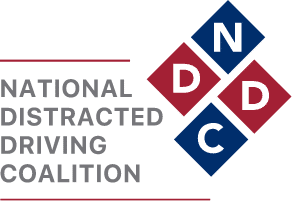WASHINGTON, D.C. — July 17, 2024— Laws and enforcement play crucial roles in addressing distracted driving, a highway safety epidemic that takes thousands of lives each year in the United States. A new report from the National Distracted Driving Coalition provides critical insight into the latest research on distracted driving laws and gives policymakers a playbook for measuring the effectiveness of laws and enforcement.
According to a recent estimate by the National Highway Traffic Safety Administration (NHTSA), more than 10,500 fatalities in the United States in 2019 involved at least one distracted driver. Most states have enacted laws aimed at curtailing distracted driving and its effects, but how they’re applied and enforced varies significantly across the country. Evaluating the Effectiveness of Distracted Driving Laws provides an overview of current applications and summarizes research into how laws can change driver behavior and reduce crashes and fatalities.
“We want this report to encourage legislators to not only strengthen distracted driving laws but also to evaluate these laws for effectiveness in changing driver behaviors and preventing crashes,” said Robyn Robertson, President & CEO of Traffic Injury Research Foundation (TIRF) and co-author of the new report. “Implementing the law is only the first step. Measuring its success – or shortcomings – is just as important. So, the bulk of the report serves as a sort of blueprint for how to measure these efforts.”
The state of distracted driving laws in the United States
New York became the first state to ban handheld phone conversations by all drivers in 2001. Since then, nearly every U.S. state has enacted some sort of distracted driving law, though the scope and features of these laws vary significantly. The new report leads with a cliffs-notes summary of the available research, examining how different laws affect various outcomes, including handheld phone use, texting, rear-end crashes and fatal crashes.
For example, a recent analysis from Cambridge Mobile Telematics (CMT) found that Ohio’s ban on handheld phone conversations led to 7.4 percent less smartphone distraction seven months after the ban went into effect. CMT estimates that the law prevented 3,200 crashes and 8 fatalities during this time frame.
Evaluation is key to success
The report also outlines available data sources, along with their strengths and limitations, proposes research questions, and provides a checklist of key steps required for an effective and accurate evaluation.
“Laws are in place to make roads safer by reducing distracted driving and associated crashes,” said David Zuby, Executive Vice President and Chief Research Officer at the Insurance Institute for Highway Safety (IIHS). “Designing a study starts with determining how to define effectiveness, whether that means changing actual behavior on the road or reducing crashes or crash rates. The report also outlines a number of critical steps that need to be taken once this determination is made.”
The Coalition’s call to action
Recognizing that jurisdictions simply cannot afford to use resources on ineffective countermeasures, the Coalition calls on stakeholders to prioritize the evaluation of laws and enforcement efforts.
“It’s reassuring that states continue to consider new and stronger laws,” said Robertson. “Our message is that ’set it and forget it’ doesn’t work. A transparent and scientific study of your efforts is essential and can help guide changes that will make the biggest impact. We hope this report serves as a helpful guide for doing so.”
To access Evaluating the Effectiveness of Distracted Driving Laws, click here.
Report to be discussed during July 23rd webinar
On Tuesday, July 23, 2024, from 1:00-2:45pm ET, the NDDC will host a live webinar highlighting the new report. The event will feature opening remarks from Michael E. Graham, member, NTSB, followed by a panel discussion with IIHS’s David Zuby, TIRF’s Robyn Robertson, and Greg Fitch, Head of Safety Research at Android Auto. The webinar will be moderated by Jennifer Smith, President & CEO of StopDistractions.org. Click here to register for the free webinar.
NDDC Steering Committee Press Contacts
Nick Chabarria
Automobile Club Of Missouri
JOE YOUNG
Insurance Institute for Highway Safety
